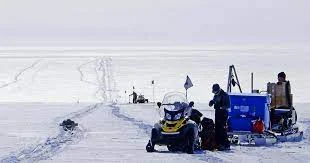Hidden rivers in Antarctica contribute to sea level rise
Beneath the Antarctic ice sheets are many rivers and lakes, due to the insulating ice sheet above, the flow of heat from the interior of the Earth below, and the small amount of heat generated by melting ice.
The Conversation website published an article - written by Hu Joseph Horgan, associate professor of geophysical glaciology at Te Herenga Waka - Victoria University of Wellington, and Craig Stevens, professor of ocean physics. In the National Institute of Water and Atmospheric Research on Feb. 10 they explain how rivers hidden under the ice in Antarctica could play an important role in sea-level rise.
What happens to the ice?
In the article, the researchers mention that the water acts as a slippery substance under the ice sheets, allowing the ice to slide towards the ocean at speeds of up to several hundred meters per year, and when the water comes out from under the ice, it enters cold and salty cavities under the ice sheets, which are the floating extensions of the ice sheets that surround the continent.
Here the water mixes, releasing nutrients and sediment, and melting the underside of ice shelves, which act as struts that impede the flow of ice sheets, “and understanding how these processes may occur over the coming centuries is a key factor in understanding sea-level rise,” the researchers say, unfortunately. This is also one of the least explored parts of our planet.
The researchers also say, "Our New Zealand Antarctic Science Program is the first direct survey of an Antarctic subglacial river, and supports previous research indicating that these subglacial rivers form estuaries as they flow into the ocean, albeit at 82.5°S, hidden Under 500m of ice and about 500km of ocean.
Exploring a river under the ice
Our team has just returned from the Camp Ice Stream on the West Antarctic Ice Sheet (WAIS), and "Camp is a sleeping giant," the researchers say.
The massive Camp Escarpment, which is rapidly losing ice, is located across from the West Antarctic Ice Sheet from the Thwaites Glacier (or "Doomsday"), and while the Camp may have flowed rapidly in the past, that flow stopped about 160 years ago. years due to changes in how water is distributed at the base of the ice.
Although the Kamp region is not susceptible to ocean warming at the present time, the ice loss there is currently greater than the ice loss that occurs elsewhere in Antarctica, and the changes in the Kamp are believed to portend major changes to the ice sheets and oceans of Antarctica.
One challenge is that ice sheets respond to external changes, such as rising ocean temperatures, but also to internal changes that are difficult to predict, such as flood events that occur when the banks of rivers and lakes under the ice fill with water. To explore the rivers under the ice, the researchers say, "There is an art to digging for Antarctic ice. In fact, we make our way with hot, recycled water."
The scientists battled high winds and temperatures of -30 degrees Celsius to reach the areas they identified from the ice shelf. Once at the site, the team was able - using hot water - to drill 500 meters into the ice shelf and keep a hole 0.4 meters in diameter open for two weeks. Roughly speaking, this has allowed sampling and observation of a variety of scientific projects.
Hidden river
Nearly a decade of research paid off when the team accurately determined the appropriate place to dig to reach the beginning of the narrow river beneath, and this was more impressive than initially thought, as surveys of glacial vents revealed a river more than 240 meters high and less than 200 meters wide. meters - much narrower than indicated by the icy landscape on the surface.
The researchers go on to say, "Working from an ice hole means that we can only search in one place, and to overcome this obstacle, colleagues from Cornell University used their ocean robot "Icefin" to study under the ice, and the last task was What the team completed is installing devices under the ice that allow researchers to measure properties such as water velocity, salinity and temperature in multiple places and for extended periods of time.
Only 5 days after the activation of this equipment, the researchers detected a tsunami from the eruption of the Hong Tonga-Hung Hapai volcano. Apart from the basic observations, these discoveries provide a strong impetus for the activation of the long-term monitoring equipment, and the team will closely monitor over the coming years any changes in the flow of Glacier, including flood events.


